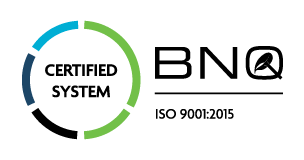The role of a sealant is to create watertightness, airtightness as well as a barrier to harmful insects. It permits air barrier continuity in building envelopes. Some sealants can also act as an adhesive and can be used as control or expansion joints in some constructions.
The role of an adhesive is to assemble similar or different materials together. Some adhesives replace mechanical fastening systems, thereby preventing metal corrosion created by screw or rivet hole drilling. Adhesives also play a sealing role, allow elongation and compression movements, as well as improve the aesthetics of certain assemblies, such as transport vehicles.
Surface cleaning is a crucial step in the success of a durable assembly or caulking. There are several methods of cleaning. Ideally, surfaces should be cleaned no more than one hour prior to application of the adhesive or sealant to prevent further contamination. See the pdf instruction: Inspection and maintenance guide for Adseal silicone weatherseal joints
- Porous surfaces (masonry, acrylic coating): Porous surfaces must be cleaned by mechanical abrasion. The surface must be ground or brushed as necessary, and the dust must be blown off with oil-free compressed air. If there is any old sealant or adhesive remaining, remove with a blade or spatula and finish mechanically to return the surface to its original state.
- Non-porous surfaces (metals, plastics): Non-porous surfaces can be cleaned most of the time with a solvent such as 99.5% isopropyl alcohol: Adseal Cleaner 6003
- use the two-cloth method, which consists of washing the surface first with a cloth dampened with cleaner and then wiping with a second clean, dry cloth before the solvent evaporates. Change cloths regularly to avoid dirt accumulation. Avoid soaking a soiled cloth in clean solvent, otherwise this will cause contamination. Choose white cloths that do not retain dust or leave lint on substrates. Make sure to clean all surfaces that will be in contact with the sealant or adhesive. Allow the solvent to evaporate properly before applying the sealant or adhesive.
- Chemical abrasion: On some substrates, solvent cleaning may not be effective. In this case, it is necessary to proceed with chemical abrasion using an acid bath. This process is quite complex and is often performed by specialized companies.
- Corona, Plasma or Flame treatment: Polyethylene or polypropylene plastics often require flame, plasma or Corona treatment. Corona treatment is done directly on the plastic extrusion line. In the case of flame or plasma treatment, it is done directly on the production line prior to adhesive application. These treatments reduce surface tension allowing a permanent adhesion of substrates.
Backer rods prevent adhesion to 3 surfaces, thereby favoring natural movement of the sealant in addition to helping determine it’s required depth. If the use of a backer rod is impossible, the use of a non-stick tape is recommended. The backer rod is available in different diameters and must be made of polyethylene. Choose a backerboard 25% to 50% larger than the joint width.
Sealant tooling using Adseal tooling kit or Adeal blue shaping tool permits 100% adherence to the surface, prevents the formation of air bubbles that could affect adhesion and creates a finished aesthetic appearance.
There are mainly 2 types depending on chemistry:
- Drying by evaporation (solvent or water)
- Thermoplastic sealant: This type of sealant dries through the evaporation of its solvent gives off a very strong odor for several days, even when used outdoors. There is great volume loss upon drying, they cannot be shaped, and they have a very short shelf life. These products can be painted.
- Acrylic latex sealant: This type contains water to varying degrees, and will therefore have less important volume loss. These products have a very limited water resistance, must be used for interior applications only and can be painted. There are 2 types of acrylic latex sealants:
- Those that can be sanded
- Those that are flexible
- Drying by polymerization: These sealants they dry by reacting with ambient humidity. This reaction time can vary depending on the sealant chemistry. Three families dry by polymerization and each are called elastomeric sealants:
- Silicone: Silicone is the most durable of all elastomeric sealants. Its lifetime can exceed 25 years. It has an exceptional resistance to ultraviolet rays and many chemical products, can be applied in temperatures below 0°C, but cannot be painted. Silicones can be used for industrial or construction applications. Two silicone examples are as follows: Adseal DWS 4580 and Adseal LM 4600
- Hybrid: Hybrid sealants include three different chemistries: MS, STPE or SPUR.These different chemistries generally behave in a similar way. They have a good resistance to ultraviolet rays, can be painted, and are mainly used for wood and composite coatings that will eventually need to be repainted. Hybrid sealants can be used for industrial or construction applications: Adseal DWSP 1940 and Adbond 1500
- Polyuréthane: Polyurethanes are organic elastomers. They have a shorter lifespan and a very low resistance to ultraviolet rays, as their flexibility is affected by the sun. This type of sealant is recommended for hidden or painted industrial applications: Adthane 1800
- Is it for indoor use?
- Is it for outdoor use?
- Will the sealant need to be painted?
- Is it for an area with vehicle or pedestrian traffic?
- Will it be immersed in water?
- Will it be for a joint with significant movement?
- Is it for a structural application, such as a curtain wall?
- Is it for a glass partition?
- Is it for a for clean room or food room (indirect contact)
- Kitchen or bathroom
- Transport vehicle
- HVAC
| Product | Interior | Exterior | Painted | Traffic | Immersion | Movement | Structural | Glass partition | Clean room or food processing | Kitchen and bathroom | Transport vehicle | HVAC |
|---|---|---|---|---|---|---|---|---|---|---|---|---|
| Adseal Production 4550 | X | X | X(p) | X | X | X | ||||||
| Adseal DWS 4580 | X | X | X(p) | X | X* | X | X | |||||
| Adseal LM 4600 | X | X | X(p) | X | X | X | ||||||
| Adseal 4200 | X | X | X(p) | X | X | X | ||||||
| Adseal Structural 4940 | X | X | X | X* | X | |||||||
| Adseal Structural 4940HV | X | X | X | X | ||||||||
| Adseal KB 4800 | X | X | X** | X | X | |||||||
| Adseal DWSP 1940 | X | X | X | X | X | X | ||||||
| Adbond 1500 | X | X | X(p) | X | X | X | ||||||
| Adbond 1530 | X | X | X(p) | X | X | X | ||||||
| Adseal CF 1070 | X | X | ||||||||||
| Adseal DWM 1090 | X | X |
p = pedestrian
* available in multiple colors
** available in translucent color only
ASTM International is an organization that writes and produces technical standards for materials, products, systems and services. These standards are used by all manufacturers in North America. Standards begin with a letter followed by numbers (e.g. ASTM C719).
The class of a sealant is determined by the ASTM C719 standard. It indicates the sealant’s ability to move, for example a class 50 indicates 50% elongation and 50% compression. Therefore a 0.5” joint will be able to elongate before rupturing up to 0.75” and compress down to 0.25”.
The ASTM C719 standard includes classes 12.5, 25, 35, 50 and 100/50. The more a joint must experience physical stress, the higher the class must be.
Adseal DWS 4580 is a class 50 neutral curing silicone sealant that can be used in many construction or industrial applications that do not require painting.
The larger the building, the more important it will be to use a 100/50 class sealant like our Adseal LM 4600, which can withstand greater movement.
Adseal DWSP 1940 is a hybrid technology, rather than a 100% silicone sealant. Its polymerization occurs when it is in contact with ambient humidity. This product is strongly suggested for construction or industrial assembly applications that need to be painted.
If the type of siding used does not need to be repainted for a few years, Adseal DWS 4580 neutral silicone can be used. If the siding is wood or composite that will need to be repainted, normally manufacturers recommend the use of a sealant that can be painted such as our Adseal DWSP 1940
Use our Online color matching tool. Afterwards you can get these colors directly from our points of sale or from one of our distributors.
Use our Online calculator tool
Select the size of the joint and the number of feet to be caulked. It’s very simple!
We highly recommend using the right tools such as:
And of course, a quality Adseal sealant.
The use of masking tape can also help to achieve beautiful joints.
Depending on different sealant technologies, life expectancy can range from 5 years to over 25 years.
Some sealants can accumulate dirt. They can be cleaned with a mild soap such as dish soap or any product used to clean windows. If the dirt is embedded in the sealant because of mold or other contaminants, it will be impossible to remove it.
Adseal KB 4800 anti-mould silicone is the ideal product for this application
On some acrylic baths, adhesion may varie. The use of a primer such as our Adseal Primer MK60095 is therefore necessary.
Carry out a preliminary test to determine the correct application method. Neutral curing silicones or hybrid sealants are not recommended for this application.
Yes by sealing it properly to avoid contact of the product with ambient humidity or to avoid evaporation in the case of solvent or water based sealants. Once opened, the shelf life may vary depending on several factors.
Due to the wide variety of substrates and substrate formulations (e.g. ABS), it is highly recommended that a test be conducted prior to sealant application to determine whether or not the use of a primer is required. If a primer is required, we suggest Adseal Primer MK60095
Structural silicone is mainly used for structural glazing (curtain walls) and architectural panels. This silicone is capable of withstanding high wind loads under various conditions. Structural silicone is mainly designed to bond glass to the aluminum structure of a curtain wall. It can be glued on 2 sides (horizontally or vertically) or on 4 sides. Please note that structural silicone should not be used as a sealant or an expansion joint.
Since the role of a sealant is to preserve the integrity of a building against bad weather (water, air and insects), it is essential to report any deficiency in the seals as soon as possible to avoid damage that is often much more costly than repairing defective sealant. To do so, a regular inspection is recommended to avoid unpleasant surprises. Consult the Inspection and maintenance guide for Adseal silicone weatherseal joints
Insulating wool can get wet and thus lose its insulating power, which is not the case with polyurethane insulating foam. Polyurethane foam, if installed properly, will conserve its properties for several years and therefore generate energy savings as well as keep you warm.
Depending on the time of year and the size of the building, the choice of insulation foam will vary. For example, in temperatures below 0°C, we recommend Adfoam Polar 1825, as it can be applied in temperatures as low as -25°C.
Note that the temperature of a foam can should be around 18°C. For applications above 0°C, we recommend Adfoam 1885-2 or Adfoam Pro 1875.
For larger buildings which will experience greater movement, we recommend Adfoam Flex 1865
This foam is one of the most flexible products on the market. It must be applied above 0°C.
Please note that all polyurethane insulating foams should never be installed above 35°C.
There are mainly two types of cans. The first uses a straw and is therefore harder to control for precise applications. The second is a can with an adjustable gun that can be screwed onto the can. This is much more precise and will allow you to conserve your can longer once you start.
The use of a can with a spray gun is strongly recommended, especially when applying on the perimeter of doors and windows. For beginners, adjust the gun pressure to the minimum so as not to apply too much. If ever there was not enough pressure during the first application, you can always apply a second layer. Fill the cavity to roughly 50% to avoid any overflow or distortion of doors and windows. The exterior part of the door or window should be closed and the application should be done from the outside to the inside. The film on the outside should remain intact to preserve its sealing capabilities. The overflow should ideally be towards the interior of the building. If there is an overflow, you can then cut it off.
Use our Adfoam Clean/500 cleaner to clean your tools as well as surfaces where spillage has occurred. Always verify the compatibility of the product in an inconspicuous place beforehand. Visible surfaces should be cleaned before a skin forms, otherwise it will be very difficult to clean properly. To clean guns, screw the cleaning can onto the application gun and rinse generously so that no polyurethane foam residue remains.
In order to preserve the flexibility of the weatherstripping, it is recommended that a coat of Adseal Lubricant 4000A2 be applied every year. This will help preserve flexibility of your weatherstripping for many years. Hinges and all moving parts should be lubricated at the same time with our Adseal Lubricant 4000A2.
Sealants should be cleaned before skin formation with a small amount of mineral spirit. Always check the compatibility of the mineral spirit with your substrate before use. If you wait too long before cleaning, it will be very difficult to remove traces of dry sealant.
The Adseal Production 4550 series neutral silicone is recommended for sealing joints in food and clean room environments:
However, a waiting period of 28 days is required following application before proceeding with any food or drug production.
We recommend using a sealant specially designed for this application, such as our Adseal 1602 Gutter sealant, which can be applied in humid environments.
It is a glass wall on commercial buildings. The glass is glued to an aluminum structure either on 2 sides (vertically or horizontally) or on 4 sides. It is therefore important that the sealant be strong enough to withstand significant wind loads that exterior buildings may be exposed to.
Certain neoprene or EPDM setting blocks may stain silicone sealant, especially if the silicone is pale. In order to avoid this issue, we recommend using silicone or pvc setting blocks, such as our Adseal setting blocks.
Yes, it is very important to remove any air bubbles that may have occurred during the application of a structural sealant. Doing so provides better support, as shaping ensures greater surface contact between the sealant and the substrate.
We recommend a silicone sealant designed for movement joints, such as our Adseal DWS 4580 series. Some glaziers prefer to use the same structural sealant in order to avoid product mixing. This is acceptable, but more expensive.
We recommend an ASTM C1521 adhesion test on site. Our technical representatives are available to help support you with this type of test.
If you prefer a translucent sealant, we recommend our Adseal KB 4800 series. However, if a colored sealant is required, we recommend our Adseal DWS 4580 series
We recommend waiting 28 days to permit complete sealant reaction and vulcanization and thereby avoid contamination.
We recommend a sealant that can be painted, as this is often required by siding manufacturers, such as our Adseal DWSP 1940 series
The available warranty is applicable to the product only. No application warranty is offered, as this is not within Adfast’s control. The warranty duration varies by product and application. We invite you to consult one of our technical sales representatives for more information.
Adseal HT 4706-3 is used for applications requiring a continuous temperature resistance of 260°C (500°F) or an intermittent temperature resistance of 315°C (600°F).
Does the surface need to be humidified before applying the polyurethane foam?
When ambient humidity drops below 30%, surfaces must be humidified to ensure proper curing of the foam.
Yes, we recommend that the can be shaken for 30 seconds. This operation must be repeated regularly to ensure a good molecular foam structure.
We recommend 4 to 10 minutes between layers
We recommend 20 to 45 minutes, depending on the polyurethane foam. We strongly recommend that the foam be cut from the inside. This will keep the outside skin intact and maintain the seal.
We recommend the following method: Cleaning procedure for hotmelt machine
A sandwich panel is an assembly of 2 or 3 different substrates such as wood & rigid insulation or wood & plastic.
Generally, a polyurethane adhesive such as our Adbond 5645 is recommended. Other products may be used for different applications.
Yes, Adbond 5645 or any of our other polyurethane adhesive formulations must be lightly dampened prior to assembly to maintain sufficient moisture and to properly cure the center of the panel. We recommend that a water mist be applied to the adhesive, representing 10% of the adhesive weight.
Yes, our new B2B online commerce platform will be available soon! We will share the link to open an account in the coming days. If you’d like to be advised of the upcoming launch, please send an email to Marketing@adfastcorp.com
You can view many tutorial, informative, and corporate videos on our youtube page
Before replacing a caulking joint, the old sealant must be completely removed. For a non-porous surface, use a sharp blade, knife or spatula. To finish, the surface can be cleaned with 99.5% isopropyl alcohol, such as our Adseal 6003. For a porous surface, use a blade, knife or spatula to remove the largest part and then remove the rest with a grinding wheel or wire brush. Blow away dirt and residue with oil-free compressed air.
On our website (wwww.adfastcorp.com), simply enter our product code. This will take you to the product page, on which you may click on the TDS icon.

Adfast offers free master drawing section review to architects. We understand that this is very important in the construction of sustainable buildings. If you are interested in a free accredited webinar or revision of your master drawings, chat with us online using the option at the bottom right of your screen, or send us an email at Marketing@adfastcorp.com
Absolutely, Adfast offers free training in person or online in the form of accredited webinars. Adfast is a member of the AIA (American Institute of Architects) and offers training organized by ATS (American Training Solutions). If you are interested in a free accredited webinar, chat with us online using the option at the bottom right of your screen, or send us an email at Marketing@adfastcorp.com
Neutral cure sealant do not contain fungicide. For bath and showers, it is recommended to use an anti-mould silicone, such as our Adseal KB 4800 series.
This operation is very difficult to perform. The quantity to be used will vary depending on the formulation chosen and the application temperature. The pressure adjustment of the gun and the speed of the application will also influence the quantity used. Our experts are always ready to help you. Chat with us online using the option at the bottom right of your screen, or send us an email at Marketing@adfastcorp.com
A cohesive failure occurs when the adhesive separates in half and remains on each sides of the surfaces to be bonded.

Adhesive failure occurs when the adhesive remains on only one of the two substrates.
No, not currently.
It is a water-based sealant for interior use only, that can be painted. Its water resistance is moderate. For an application where water resistance is required, we recommend the use of a silicone sealant.
If this type of product interests you, we recommend ADSEAL 1090
Yes, because water will evaporate from the product upon drying. Due to this fact, a second coat may therefore be necessary.
Yes. When a large quantity is applied, the sealant may crack, in which case a second coat may be required.
Adseal CF 1070 is a gap-filling latex acrylic sealant that can be sanded. It is thicker and less flexible than Adseal DMW 1090. Adseal DWM 1090 is a flexible latex acrylic sealant used in finishing joints. Both products have a moderate water resistance.
A hot melt adhesive can be used in applications with several heating and cooling cycles. This type of adhesive requires the use of a heat gun or heating machine for industrial applications.
The 3 most common families of hot melt adhesives in the industrial market are:
1) EVA (ethyl vinyl acetate)
These products are generally used for cardboard packaging applications but can also be used for several other industrial applications.
As an example Thermobond 7104
2) PSA (pressure sensitive adhesive)
These products remain tacky, even after cooling. They are used in a multitude of industrial applications that require a moderately long open time. They are also used for self-adhesive products such as diapers, sanitary napkins, fly and rodent traps.
As an example Thermobond JPS70300
3) APAO (Amourphous Poly Alpha Olefin)
These products have higher heat resistance and remain flexible when cooled. They are used in mattress manufacturing as well as a variety of other applications.
As an example Thermobond JPS70154
Depending on families and formulations, application temperatures can vary between 110°C and 218°C (225°F and 425°F).
Adfast recommends the use of a polyurethane sealant for hidden applications or industrial markets that require a paintable sealant.
If this type of product interests you, we recommend Adtane 1800 Series
Some manufacturers promote polyurethane sealants in construction markets. We disagree, as polyurethane sealants are organic products which have little resistance to ultraviolet rays. They will quickly deteriorate, crack and lose their flexibility depending on their exposure to ultraviolet rays.
It is a hybrid adhesive sealant that does not contain isocyanate, as opposed to a polyurethane adhesive sealant. It has good resistance to ultraviolet rays and can be painted. It has equal or superior strength compared to polyurethanes. Adbond 1502 or 1510
The primary industrial markets include transportation vehicles or HVAC manufacturers. Certain very flexible versions may be used in the construction industry.
Young’s modulus of elasticity (longitudinal) or tensile modulus is the constant that relates the tensile or compressive stress and the onset of deformation of an isotropic elastic material. For example, when sealing your bath you should use a high modulus sealant, because when you fill the bath it adds weight which will pull the sealant down. If you use a low modulus sealer this movement could cause your sealer to tear.
Low modulus silicone sealant products offer excellent adhesion to almost all building and glazing materials. Low modulus products are more elastic and well suited to sealing tasks that need to accommodate movement without failing.
Yes, some sealants are used as adhesives, such as structural silicones that bond glass to the aluminum structure of curtain walls. Some hybrid or polyurethane sealants also have excellent adhesive properties.
It is a sealant or adhesive that dries by chemical reaction between a resin and a catalyst (Adbond 5531). These products have the advantage of drying faster. They can also be used where a bead depth is greater than 13 mm (5/8”). They are mainly used for applications where fast drying is required. Two-component products are mainly used in industrial production but also sometimes on construction sites.
Our Adbond EX 5690 or Adbond Extreme 5692 are excellent products for this type of application. They offer a fast, initial set and effective long-term bonding.
Our silicone Adseal DWS 4580 is recommended for this application, as you must use a sealant color close to the selected copper once aged in order to have an aesthetic color match. Copper metal color changes with age.
An organic sealant such as polyurethane, has a C-C-O-C chemical link (c= carbon / O = oxygen).
Carbon atoms have very poor resistance to ultra-violet rays, which will cause short- to medium-term deterioration of the sealant (loss of flexibility, cracking, etc.)
Silicones do not have carbon atoms. They have an Si-O-Si-O chemical link (Si = silicon / O = oxygen) which gives them superior resistance to ultraviolet rays.
Ideally a ratio of 2:1 (width / depth) should be respected. For example, a 19 mm (¾”) wide joint should have a depth of 9.5 mm (3/8”). The maximum joint depth should not exceed 15.8 mm (5/8”) in most joint designs.
The maximum ratio is 3:1 in the case of structural silicones. The maximum joint depth should not exceed 15.8 mm (5/8”) in most joint designs.
Longer life expectancy, more UV resistance, faster tack-free time and greater versatility with high or low application temperature.
It means 50 percent movement capability (elongation/compression)
- Mechanically remove 100% of the old sealant, if required
- Clean with isopropyl alcohol (IPA) solvent
- Insert soft backer rod or install non-stick tape when use of backer rod is not possible
- Apply sealant, shaping the bead with an appropriate tool
The acetoxy silicone.
Tooled, hour-glass sealant bead with minimum 1/4″ substrate contact.
- Install the sealed units using temporary pressure plates to support regional wind load
- Install the structural silicone and tool it to avoid any air bubbles between the sealed unit and the aluminum structure, cleaning silicone excess before curing
- Leave the temporary pressure plates for 21 days at 73°F/23°C, 50% relative humidity
- After 21 days, remove temporary pressure plates and install the perimeter sealant
Soft, open cell backer rod.
Division 07 (Thermal and Moisture Protection) and Division 08 (Openings).
1/4″ minimum depth; 1/2″ maximum depth



















